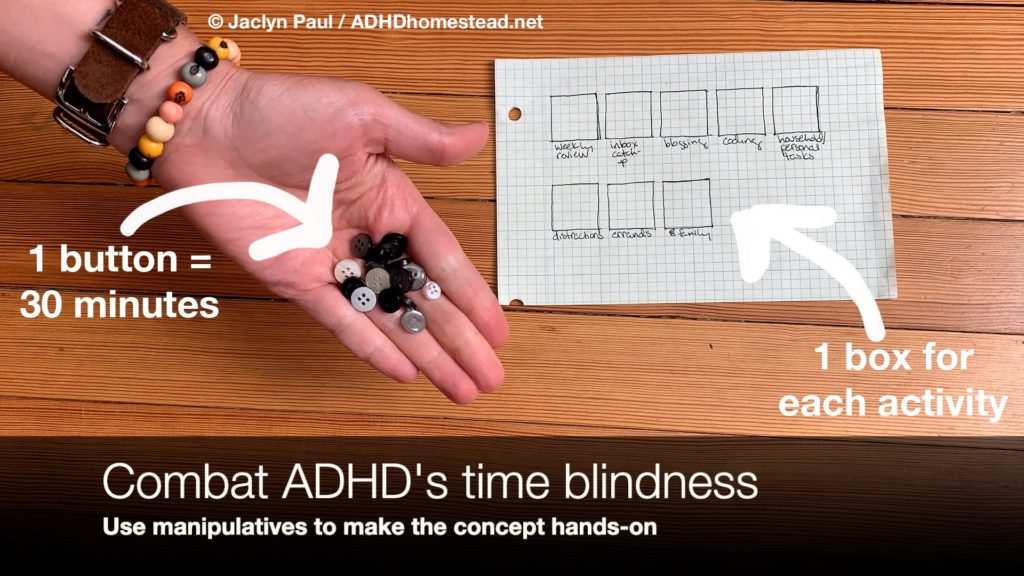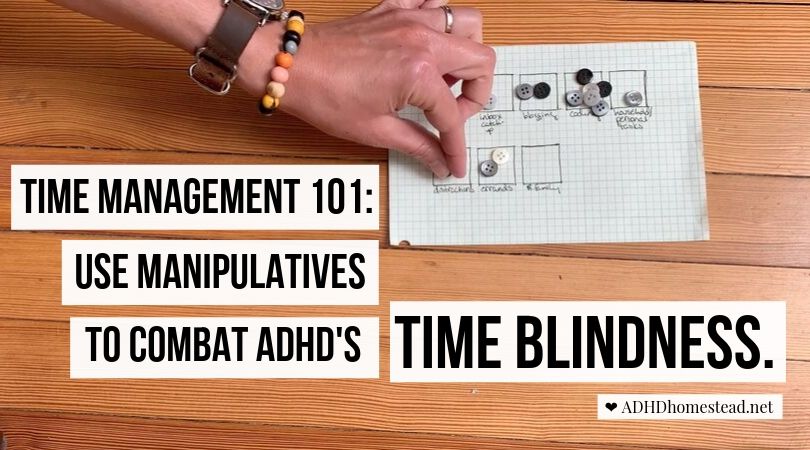This summer put a huge strain on my time management skills: my schedules and routines shifted weekly, I’d committed to complete two big projects by the fall, and I was alone for either far fewer or far more hours each day than I was used to. This would be a struggle for anyone. Even more so for someone with ADHD. I needed a tool to help me figure it out.
That tool — a system that took me five minutes and zero dollars to create — was such a hit with my ADHDgram subscribers I felt it deserved its own blog post.
The solution was simple: find a way to represent time intervals with physical objects I could distribute between activity categories. I used buttons, but any small objects would do. My buttons helped me plan my time at the beginning of the day and figure out where it all went at the end. A reader who works as an educator clued me in to the technical term for these objects: manipulatives.
Manipulatives offer a “developmentally appropriate” hands-on interaction with an abstract concept. Considering the fact that many adults with ADHD have yet to develop a firm grasp on the concept of time, this system seems very developmentally appropriate indeed. It taught me a lot and it might teach you a lot, too.
A cautionary note, and why I used buttons and scrap paper.
Having lived every year of my life with ADHD, I know better than to go all-in on a new organizing tool. Nowadays I try to test out the process before investing too much money or time collecting gear. Impulsive soul that I am, I also wanted to implement my new idea right away. That’s why I used materials I already had sitting around the house.
Most of the time there’s a way to test-drive new ideas without spending too many of our precious resources (time, money, attention). I encourage you to look for that way. If you fall in love with a system and want to officialize it with better supplies later on, keep that in mind as a reward for sticking with it for more than a few weeks.
Budgeting and tracking time with manipulatives: what I did.
If you want to recreate my time tracker and try it out for yourself, here’s how to do it:
- Define broad activity categories or areas of responsibility. How do you spend your time? Some examples include:
- Phone calls
- Emails
- Errands
- Writing
- Meetings
- Paperwork/administrative tasks
- Social media
- Kids’ activities
- Choose a place to physically represent these categories. I started with square regions on a piece of graph paper. A reader suggested coloring in squares/dots in a Bullet Journal if you need portability.
- Find a collection of small objects you can use as manipulatives to represent chunks of time. I used one small button for each half-hour increment. Again, you can recreate this in a Bullet Journal if you need to.
- Use your manipulatives to budget and track how you spend your time each day. I counted out a pile of buttons in the morning to represent all the available hours in my work day. They helped me see the potential in my day and budget how much time I wanted to spend on each area of responsibility. As time passed, I placed buttons in the appropriate area on my tracker to record how I did.
Manipulatives help counteract ADHD’s time blindness.
If my email inbox and web traffic are any indication, time blindness causes us a lot of suffering. It feeds many of ADHD’s most crippling impacts on our adult lives. One way to combat this weakness in perception is to bring it out of the abstract and into the real world — maybe even into the palm of our hand.
I learned a great deal about my own perception of time from this button exercise. It could probably fill its own blog post, but I’ll summarize the main points here:
- Even on days when I felt like I had a pretty decent grasp on my time, I sometimes ended up with leftover buttons. Where had that time gone? I learned that I needed to account for basic life stuff: eight hours in the office does not equal eight hours of available work time. We should expect to eat lunch, refill our water bottles, use the bathroom, and stare out the window once in a while.
- I often let a small disruption — say a mid-morning meeting — throw off my game for the entire day. When I counted my buttons in the morning and removed a few for that morning meeting, I experienced a total paradigm shift. I had almost all my buttons left! That motivated me to work productively around the meeting. I now realized I hadn’t actually lost that much time.
- Hyperfocus wrecks my perception of time. When I disappeared into that deep flow state (usually coding), I forgot when I’d started the task and had no idea how long I’d been at it. Sometimes I couldn’t even estimate within an hour how I’d been working. The buttons helped me retrace my steps on those days. I also started setting a timer to remind me to come up for air every once in a while.
- It’s easy to lose track of how much time we spend on mundane tasks like replying to emails. Creating a physical representation of this time every day prompted me to reconsider email’s role in my life. I started closing my email program while working on other things and setting aside specific times to focus on email.

Even if you don’t share your time tracking with anyone, it can motivate you to do better.
Accountability partners can often help us stay motivated toward our goals, but I don’t feel comfortable asking friends and family for support on everything I try to do. Enlisting one-on-one help makes more sense when you only have one or two problem areas. I want accountability and coping systems I can use without relying on others all the time.
Many adults with ADHD also carry a large burden of shame. We already feel anxious about others’ perception of us. We may not want to admit that we need help figuring out whether we spent one hour or three working on a project.
My button tracking experiment gave me an unexpected gift in this department. Much like dieters lose more weight when they keep a food log, the simple act of recording my behavior changed how I spent my time.
Because we ADHDers are often blind to any moment except the one happening right now, it’s easy to forget a slip-up. The pain of an hour spent mindless scrolling Twitter fades quickly — unless we write it down. When I felt myself approaching the threshold where I’d have to record a significant chunk of time spent on a distraction, I usually chose to close that browser tab and get back to work.
Give it a try — it won’t cost you anything.
My favorite thing about this exercise was its simplicity: I didn’t have to buy supplies or spend a lot of time setting up a new system. I also didn’t have to feel guilty if I fell out of the habit and didn’t use my time tracker for a few weeks. I could take as much or as little as I wanted from it without feeling pressure or shame.
If you try it out, I’d love to see what you come up with! Send me pictures or notes of your found-object time trackers, along with your lessons learned. Just tag me on Instagram (@jaclynpaulwriter) or Twitter (@jaclynleewrites) or post a comment below.
Hey there! Are you enjoying The ADHD Homestead?
Here's the thing: I don't like ads. I don't want to sell your attention to an advertising service run by the world's biggest data mining company. I also value my integrity and my readers' trust above all, which means I accept very few sponsorships/partnerships.
So I'm asking for your support directly. For the cost of one cup of coffee, you can help keep this site unbiased and ad-free.
Below you will find two buttons. The first lets you join our crew of Patreon pals and pledge monthly support for my work. Patrons also have access to my Audioblogs podcast. The second takes you to a simple donation page to pledge one-time or recurring support for The ADHD Homestead, no frills, no strings. Do whichever feels best for you!

